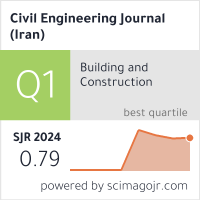Determining the Causes of Punching Shear in Reinforced Slabs Using Fishbone Diagram
Downloads
Risk identification and assessment can be analysed using many risk management tools. Fishbone diagram is one of these techniques which can be employed, for the identification of the causes behind the construction failure, which has become a phenomenon that often gets repeated in several projects. If these failures are not understood and handled scientifically, it may lead to disputes between the project parties. Additionally, the construction failure also leads to an increase in the project budget, which in turn causes a delay in the completion of the projects. Punching shear in reinforcement slab may be one of the reasons for construction failures. However, there are many doubts about other causes that lead to this failure as well as the role of these causes in the construction failure. Also, there are many causes linked to this failure of which some fall on the designer and the others fall on the contractor. Thus, this research aims to determine the causes of punching shear failure in the concrete slab and its role in the failure using a logic managerial analysis. For this purpose, the applicability of the Fishbone diagram has been extended, for the analysis of probability as well as the impact of the risk of punching shear, thus elucidating the risk score of each category without ignoring the global risk. In this direction, interviews and questionnaires are conducted with numerous experts specialize in both the design and execution field of construction projects for identifying the most important causes that lead to the occurrence of punching shear failure. Further, the Fishbone diagram for punching shear's risk illuminated that impact of some of the primary and secondary causes such as planning, designing, and maintenance is more than the expectation. Therefore, the concentration in these areas should be carried out by taking into consideration the adapt risk response plan to prevent or mitigate these risks.
Downloads
[2] J. Aalto, "Comparison of punching shear design provisions for flat slab" TRITA-BKN. Master Thesis 517, Concrete Structures, June 2017.
[3] D. D. Shinde, S. Ahirrao, and R. Prasad, "Fishbone diagram: Application to identify the root causes of student-staff problems in technical education" Wireless personal communications, May 2018, Volume 100, Issue 2, pp 653–664. doi: 10.1007/s11277-018-5502-2.
[4] T. Y. Luo, C. Wu, and L. X. Duan, "Fishbone diagram and risk matrix analysis method and its application in safety assessment of natural gas spherical tank," Journal of Cleaner Production, vol. 174, pp. 296-304, Feb 10 2018. doi: 10.1016/j.jclepro.2017.10.334.
[5] G. F. Wang "Defect Identification and Quality Control of Steel Structure Installation Projects Based on Fishbone Diagram", Applied Mechanics and Materials, Vol. 340, pp. 104-108, 2013. doi: 10.4028/www.scientific.net/amm.340.104.
[6] Niu, Dong Xiao, Huan Huan Qiao, Hui Juan Zhai, and Xin Lu. "Power Grid Construction Project Cost Risk Factors Analysis Based on the Fishbone Diagram Theory.” Advanced Materials Research 622–623 (December 2012): 1852–1855. doi:10.4028/www.scientific.net/amr.622-623.1852.
[7] P. Olmati, J. Sagaseta, D. Cormie, and A. E. K. Jones, "Simplified reliability analysis of punching in reinforced concrete flat slab buildings under accidental actions," Engineering Structures, vol. 130, pp. 83-98, Jan 1 2017. doi: 10.1016/j.engstruct.2016.09.061.
[8] L. F. Hussein "Punching shear behavior of bubble decks under eccentric loads" Master of Science thesis submitted to the University of Baghdad, 2017.
[9] S. Ericsson and K. Farahaninia, "Punching shear in reinforced concrete slab on edge steel columns" Master of Science thesis in the master's program structural engineering building performance design, 2010.
[10] B. Belletti, M. Pimentel, M. Scolari, and J. C. Walraven, "Safety assessment of punching shear failure according to the level of approximation approach," Structural Concrete, vol. 16, pp. 366-380, Sep 2015. doi: 10.1002/suco.201500015.
[1] M. Ju, C. Park, E. S. Hwang, and J. Sim, "Predictability evaluation of the existing punching shear formulas using failure test and probability-based approach," Ksce Journal of Civil Engineering, vol. 19, pp. 1420-1430, Jul 2015. doi: 10.1007/s12205-015-0040-x.
[12] S. Chandrasekaran, "Offshore structural engineering: reliability and risk assessment: CRC Press, 2016. doi: 10.1201/b21572.
- Authors retain all copyrights. It is noticeable that authors will not be forced to sign any copyright transfer agreements.
- This work (including HTML and PDF Files) is licensed under a Creative Commons Attribution 4.0 International License.![]()















